 SVR S&T Dept.
SVR S&T Dept.

SIGNALLING NOTES - Chris. Hall
As I write these notes the Winter shutdown work is occupying all of our spare time! In the last issue (issue 209) I reported that our preparation was complete: we have a refurbished three-lever ground frame with an Annet’s key release in the stores.
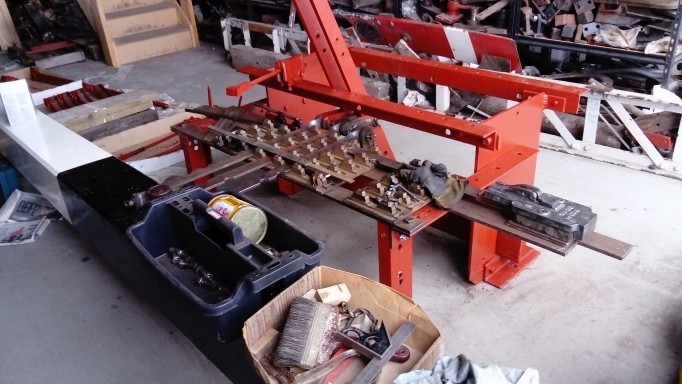 On 21 August 2019 the ground frame for Foley Park nears completion.
On 21 August 2019 the ground frame for Foley Park nears completion.
We had loaded three cable drums into a brake coach on Sunday 29th December, intending to take the cable to the work site at Falling Sands once the track had been replaced and partially ballasted and a troughing run had been laid on the surface.
Foley Park Sidings was the focus of our remaining Winter work with the work split into stages. On 30 December we had disconnected the cables which ran from the location cupboard at the Up Homes across the viaduct and on to the Up Distant. The signalling cable was cut short so that it would run from the Up Distant (location 52) to a new cupboard, a little closer to Bewdley than the redundant cupboard so that the power cable could be diverted to the new cupboard. The newly built cupboard was left ready at Kidderminster for transport to site during the week.
We had cut and threaded some replacement handrail supports for the Kidderminster Up Homes and on 5 January took a trolley from Kidderminster out as far as we could go towards the Home Signal. This meant that we only had to carry the portable generator a couple of hundred yards. The signal had been scaffolded so that we could remove the timber platform and handrails leaving better access for the painting team. On 5 January therefore our resources were split - the electrical section on the Bewdley side of the viaduct terminating cables in the new cupboard and the mechanical section removing the old timbers from the Up Home.
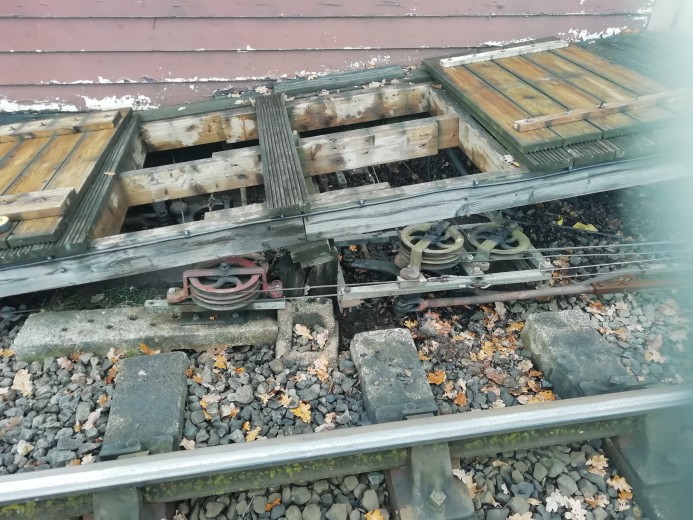 A survey of the Hampton Loade lead off on 21 November 2019. All of the cranks and wheels will have to be removed in January 2020, as well as the walkway ramp to allow replacement of the timbers below.
A survey of the Hampton Loade lead off on 21 November 2019. All of the cranks and wheels will have to be removed in January 2020, as well as the walkway ramp to allow replacement of the timbers below.
Replacing the lead off cranks at Hampton Loade was also planned for January - this was one of our major pieces of Winter work. A visit was made on Sunday 12 January to disconnect all signals and points. A contractor removed the walkway and the four damaged timbers (these are 12″ x 5″ in section and ten feet long) and installed two new timbers. Our visit on 19 January to fit the south end cranks was successful and by our next visit on 26 January the remaining timbers had been fitted and the walkway reinstated. We fitted the remaining cranks and signal wire wheels and recommissioned the points and signals. We cleaned the four point clips and replaced them in the cupboard. We were fortunate to have such good weather. We hoped that the cleaning gang, due to visit the following weekend, would not notice the few muddy footprints we had left on the floor.
Tony (Fred) Cotterell had agreed to take on the role of Project Leader for the work required to protect the newly laid points in the single line and a site visit on 18 January was arranged so that we could see where the points had been placed, something which had been a matter of some debate.
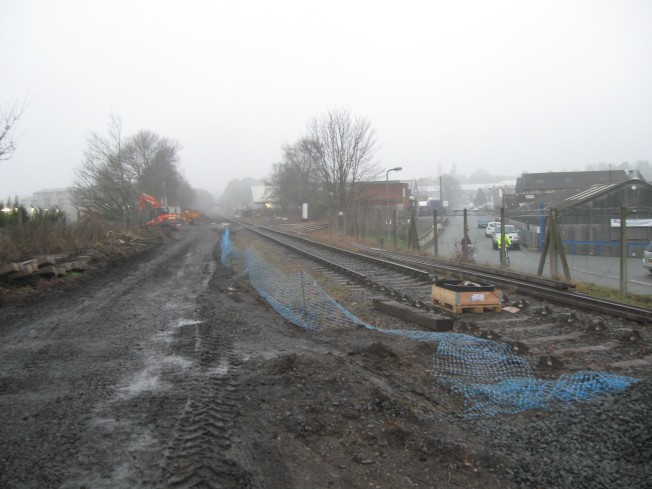 A rather misty view on 18 January but the defunct location cupboard 53 from the Home Signal berth track, which just contained power supplies for two track feeds, stans on the Up side cess. The photographer is stood about where the siding poits will be laid and to the right can be seen the point where the fence line steps back.
A rather misty view on 18 January but the defunct location cupboard 53 from the Home Signal berth track, which just contained power supplies for two track feeds, stans on the Up side cess. The photographer is stood about where the siding poits will be laid and to the right can be seen the point where the fence line steps back.
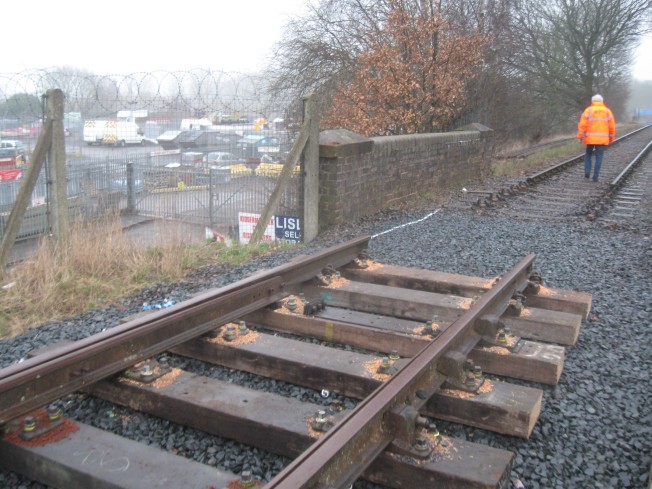 The main line points have just been assembled on 18 January but are not yet ready for our attention as no stretchers have yet been fitted. What appears to be an ideal location for the ground frame is not feasible as the fence line is too close to the track here.
The main line points have just been assembled on 18 January but are not yet ready for our attention as no stretchers have yet been fitted. What appears to be an ideal location for the ground frame is not feasible as the fence line is too close to the track here.
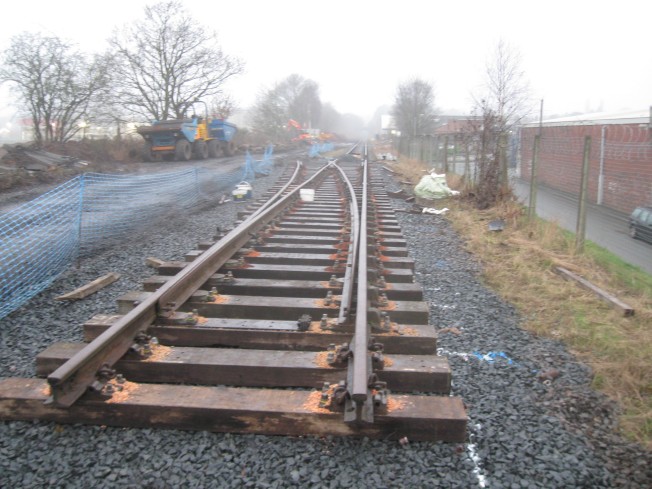 Another view of the points on 18 January - a position just beyond the dumper truck appeared to be a suitable location for the ground frame, on the Down side of the line just beyond the siding points although this might be rather close to any heavy lorry delivering a locomotive once work was complete.
Another view of the points on 18 January - a position just beyond the dumper truck appeared to be a suitable location for the ground frame, on the Down side of the line just beyond the siding points although this might be rather close to any heavy lorry delivering a locomotive once work was complete.
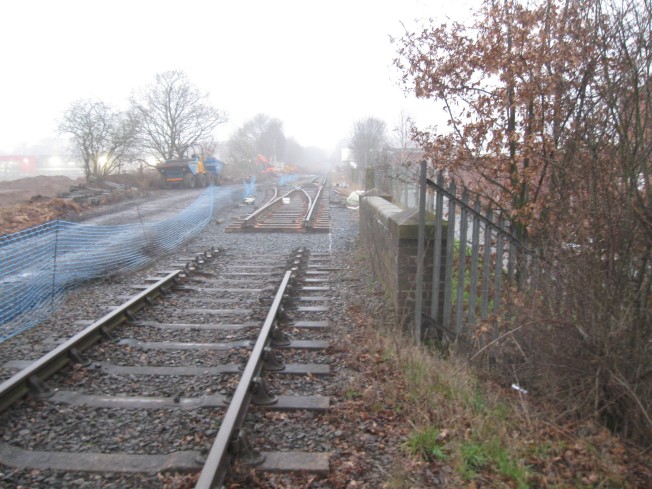 Looking across the Lisle Avenue underbridge on 18 January.
Looking across the Lisle Avenue underbridge on 18 January.
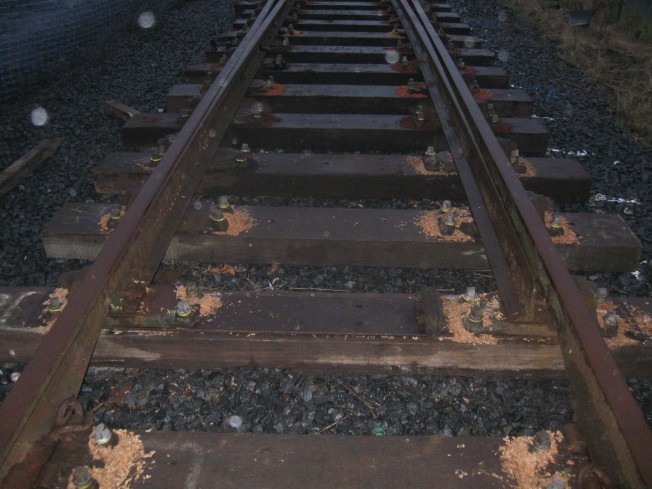 A close up of the main line points on 18 January - the insulated solebar is already drilled to take a B.R. facing point lock casting bute will have to wait for the P.Way stretchers to be fitted before starting work.
A close up of the main line points on 18 January - the insulated solebar is already drilled to take a B.R. facing point lock casting bute will have to wait for the P.Way stretchers to be fitted before starting work.
Anticipating that we would need to apply track circuit bonds to any sections of track that had not been welded by 21 March, we had obtained a replacement petrol motor for our rail drill. On 2 February we designed an alternative mounting arrangement for the motor as the mounting was quite different. Unfortunately the flexible coupling did not survive this stage and a replacement was ordered. Fortunately the 1501 group had some aluminium struts that looked just the job for the new mounting.
Back to Foley Park the next weekend, we had to drill the sleeper and solebar to take a FPL (facing point lock) casting and drill the rail so that the electrical detection box could be mounted. On 9 February we therefore commandeered the P-Way van to take a diesel generator to site and drill the necessary holes to fix an FPL casting to the solebar and sleeper. We managed to fit the FPL casting and drill two pilot holes in the stock rail for the detection box which we had refurbished. We marked up the FPL stretcher and returning to Bewdley, machined it to fairly tight tolerances.
Unusually we resorted to occasional extra mid week days to make sure that we met the deadline of the end of February for completion of the mechanical work necssary for resumption of services. On Friday 14 February, with no trains running between Kidderminster and Bewdley, a shopping list of the bits and pieces was assembled so that work on the Sunday could get off to a flying start.
On Sunday 16 February the weather in Worcestershire was beginning to cause problems. Pershore was almost cut off by floods and the main road from the M5 to Kidderminster was closed due to flooding. A diversion via Worcester and the west side of the river was advised by a very helpful policeman manning the road block.
Despite a late start, I was joined by Martin Wood, rostered as Bewdley DSM, once the engine had departed and James Marrion once through the floods north of Bridgnorth. With no power source, we had to use a hand ratchet drill to open out the pilot holes in the rail to 3/4". We bolted the detection box to the rail and measured up. Some machined parts would be required especially for the shortest detection slide and a support strap of a rather precise shape would be required to hold the detection box in the correct alignment. The machined FPL stretcher was fitted and checked for correct size with a point gauge. Two short lengths of point rodding would be required for the detection slides and these were cut to size when we returned to Kidderminster.
On Friday 21 Feb Tony Neath and John Smith were able to manufacture the parts required - a short rod and threaded boss for the normal closed switch detection and a strap bent to shape to fit between sleeper and detection box. This meant that we were able to fit the detection slides and FPL stretcher on 23 February and to carry out a full adjustment and mechanical test of the equipment. We also fitted the drive piece to the P-Way stretcher and measured up the FPL drive so that the necessary insulated components could be made up.
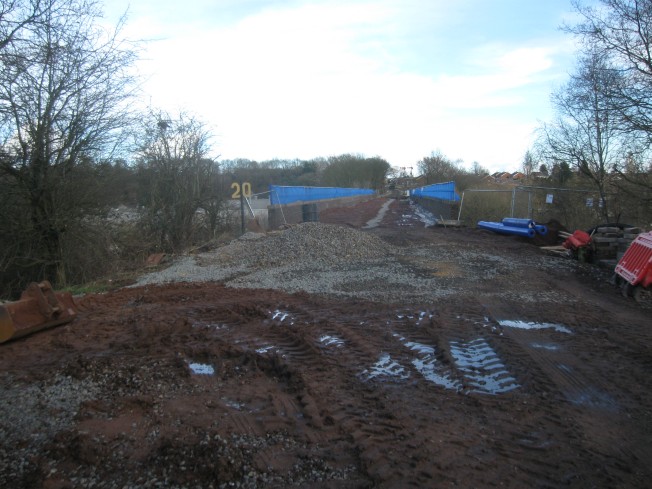 Another view on 23 January looking East over Falling Sands Viaduct.
Another view on 23 January looking East over Falling Sands Viaduct.
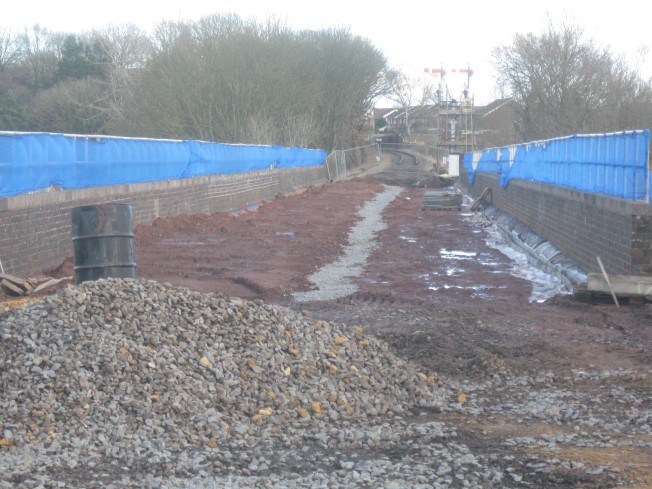 On 23 February the viaduct has been infilled but our work does not require us to cross over it.
On 23 February the viaduct has been infilled but our work does not require us to cross over it.
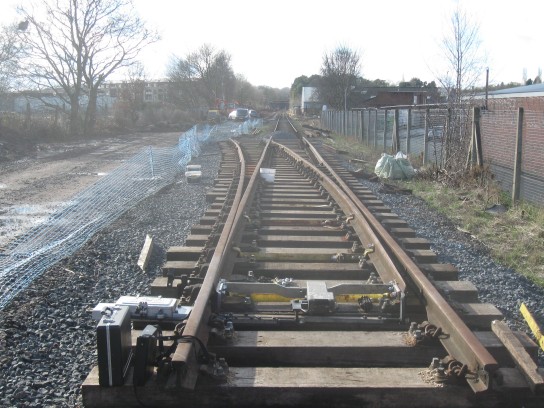 On 23 February 2020 the work is mechanically complete (apart from fitting the FPL plunger which has been installed, tested and taken away for safe keeping). [Photo: Author]
On 23 February 2020 the work is mechanically complete (apart from fitting the FPL plunger which has been installed, tested and taken away for safe keeping). [Photo: Author]
By 1 March the painting gang had completed painting of any parts on the bracket signal that would be inaccessible with the timbers renewed. We therefore took a trolley out to site, taking a blockade of the station area as there were no other movements planned. The handrails and supports had been painted and the new timbers cut to size and to fit around the signal posts. The wind had dropped (gales had been forecast but had blown themselves out on Saturday night). We were therefore able to fit the new timbers and drill the necessary holes to fit coachbolts and handrails.
Some shunting on 7 March was planned to get our cabling train ready for the following day. A short signalling turn on my way to Bridgnorth provided a convenient opportunity. Naturally the Yard keys were signed out when I arrived and the crossing was open for road moves with noone in sight. I locked everything up and put the signal lamps on hoping to attract some attention. A Shunter and a diesel driver duly appeared and I was able to contact our Driver saying there was a Shunter on duty and the 08 was ticking over ready for the shunt. The cable coach was dragged into the platform and some spades and picks loaded so that we would be ready to set off on the Sunday at 1000 sharp.
On 8 March we met for breakfast at AJ's (too early for Kidderminster buffet on what was a non-running day for Kidderminster, although they did offer to open a bit earlier for us). Contrasting the breakfast provision at AJ's, our buffet and Wetherspoons I have to say the (volunteer) price is very similar at all three but our buffets beat Wetherspoons for both quality and price. Eleven of us boarded the train, including crew and travelling signalman and set off for the work site, not long after 1000. We arrived about two hundred yards away from the Up Homes and walked to site. The contractors had laid us a troughing run across the viaduct and up to the new location cupboard so all we had to do was to remove a sprinkling of ballast and get the lids off.
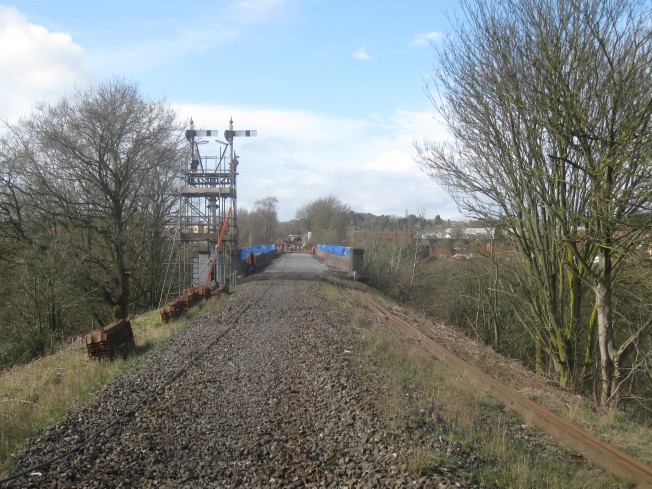 The first cable has been carried across and is about to be cut to length. It is 1051 so we are making good progress.
The first cable has been carried across and is about to be cut to length. It is 1051 so we are making good progress.
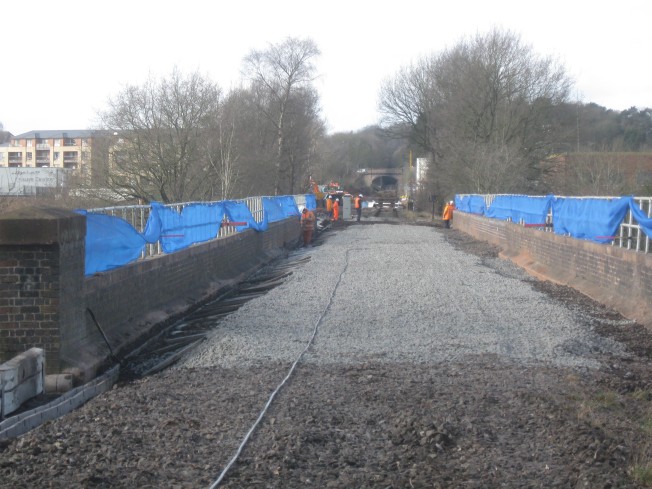 The ballast over the viaduct has been finished ready for P.Way attention in the first week of March just gone. There is no sign of the P.Way appearing yet over the horizon (Hoo Road Bridge).
The ballast over the viaduct has been finished ready for P.Way attention in the first week of March just gone. There is no sign of the P.Way appearing yet over the horizon (Hoo Road Bridge).
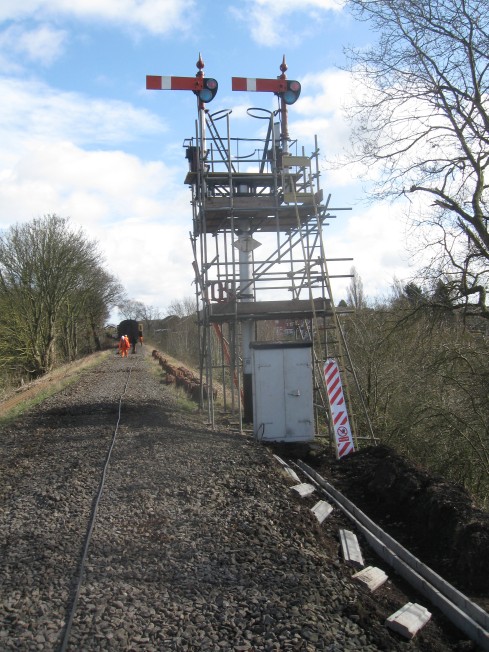 We are preparing to pay out the second cable on 8 March.
We are preparing to pay out the second cable on 8 March.
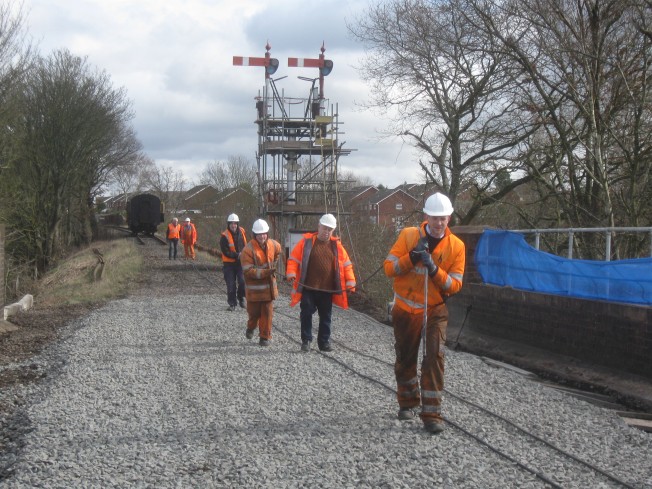 The chain gang makes its way past the Up Homes with the third and lightest cable on 8 March.
The chain gang makes its way past the Up Homes with the third and lightest cable on 8 March.
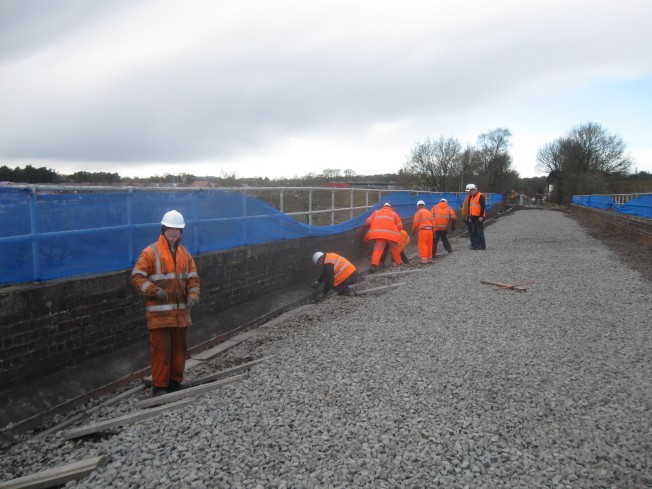 By 1156 on 8 March all three cables are in the troughing and the lids are being replaced.
By 1156 on 8 March all three cables are in the troughing and the lids are being replaced.
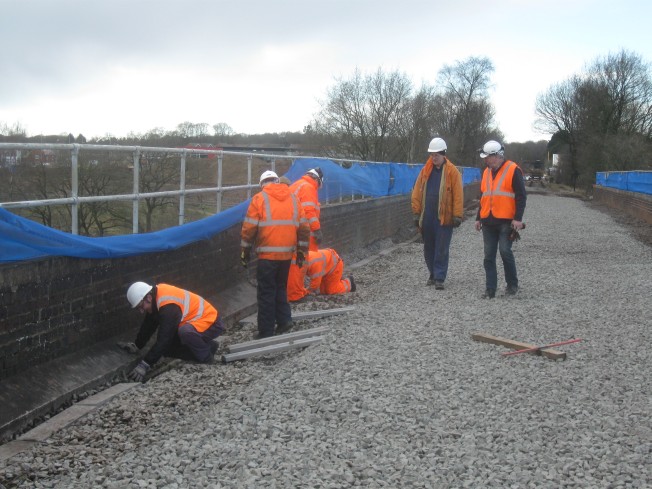 Any stray ballast in the troughing is being removed and the lids settled in place.
Any stray ballast in the troughing is being removed and the lids settled in place.
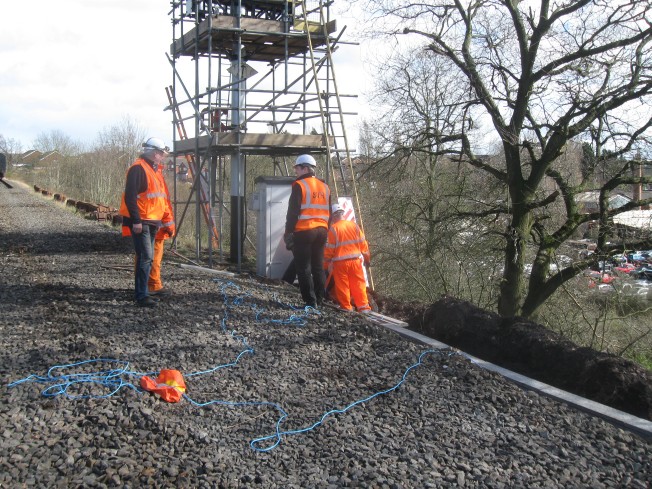 By 1245 a draw rope has been included in the troughing and thoughts are turning to lunch. One job remains - to mark the estimated position of the toe of the siding points, 64m from the toe of the main line points, ready for a meeting the next day.
By 1245 a draw rope has been included in the troughing and thoughts are turning to lunch. One job remains - to mark the estimated position of the toe of the siding points, 64m from the toe of the main line points, ready for a meeting the next day.
Each cable was paid out and carried across the viaduct and laid on the ballast. By lunchtime the cables were in the troughing and had been cut to length and threaded into the location cupboards each end ready to be terminated that afternoon. By the time we sat down in the Museum for lunch we numbered fourteen which included two cleaners from Bewdley and the Bewdley DSM. Two of us then left for Bewdley to machine the coupling pieces and to cut a slot in a concrete lid for the cable.
The next day we met on site with the P-Way and the works foreman to confirm the exact position of the concrete plinth for the ground frame. This was a useful meeting as we could establish with some certainty exactly where the siding points would be laid and the final rail height. Looking towards Bewdley, the P-Way were just appearing over the horizon as they were relaying track from the Up Distant to wards the Up Homes, only slightly behind schedule.
Sunday 15 March was a little more relaxed, myself, John Smith and James Marrion went to Foley Park to fit a 10″ x 15″ crank to the timbers of the new point before it was covered in deep ballast. Tony Neath and Martin Wood went to Bewdley to commission the rail drill, complete with its new coupling. This would be needed to drill holes for track circuit bonds on any relaid length that had not been welded.
Sunday 22 March had been planned for the essential major recommissioning. By 1245 a draw rope has been included in the troughing and thoughts are turning to lunch. One job remains - to mark the estimated position of the toe of the siding points, 64m from the toe of the main line points, ready for a meeting the next day. work - the cabling between locations 55 (section signal), 54 (Up Homes), 53 (new location cupboard for berth track circuit and new pointwork) and 52 (Up Distant) had all been disconnected, diverted and reterminated. Although the cables at locations 52, 53 and 54 to the track circuit connections had not been completed (we need track to be in place to do this!) all of the cabling from the Up Distant to the signal box, including the box to box phone, and new wiring in the signal box to provide block shelf indication for the new pointwork was complete. We would need at least a dozen personnel to do this testing.
On March 16th government advice was issued ‘to avoid all non-essential contact with others’ and on 20 March bars, cafés and restaurants were advised to close. Relevant legislation was enacted on 26th March and so we were just able to beat the clock!
22nd March was a very productive day and had taken a lot of organising. It was fortunate in that ‘social distancing’ was already built in to the plan as the personnel would be well separated - two at Bewdley South, one each at locations 52 (Up Distant), 53 (new pointwork), 54 (Up Homes), two at location 55 (Down Outer Advanced Starting signal) and three at Kidderminster box. From around 1030 to 1600 the various circuits were tested, wire by wire, with radio contact just possible as far out as the Up Distant, only a few messages having to be relayed. This included function testing (proving, inter alia, that the section signal would return to danger if normal detection of the new facing points was lost and that the single line controls were functioning correctly).
There was no point in stopping for lunch as there was nowhere to obtain it. On our way back, we noticed that the concrete plinth for the new ground frame had been cast.
As the P. Way had not quite finished relaying the track, the track circuit relays for AC, AB and AA3 track circuits were strapped out to permit testing to be completed. The testing was successful and this (and the fact that Sprng had just started) marked the end of our Winter works. These works had comprised renewal of the lead off cranks at Hampton Loade, renewal of the timber platform on Kidderminster’s Up Homes, replacement of the motor for the petrol driven rail drill, including redesign and realignment of the mounting, equipping the new pointwork at Foley Park so that it would be safe to run trains over them with indication provided in the supervising signal box, renewal of the signalling cable over Falling Sands Viaduct and provision of a new location cupboard for the electrical equipment to monitor the new points.
All of the Winter S&T work was completed to time and in budget. All that is left to do is to connect the track circuit cabling to the rails (once they are in place) and to test each track circuit locally. Otherwise the S&T work is complete for reopening between Kidderminster and Bewdley. On completion of our work on 22 March it was unfortunate that we could not gather together to celebrate and congratulate ourselves and it was a bit of an anti-climax as we simply waved goodbye and went home. Since then we have been in ‘lockdown’ and no further S&T work is taking place for the moment.
The signal box diagram in Kidderminster Station box will also need updating to show the new connection even though the ground frame and the sidings have not yet been laid. This all needs to be done before services resume.
 How the signal box diagram will look once the ground frame has been installed.
How the signal box diagram will look once the ground frame has been installed.
A reminder that this article, as well as other information on Signal Engineering, can be viewed in full colour here on the unofficial Signal Engineering web site.